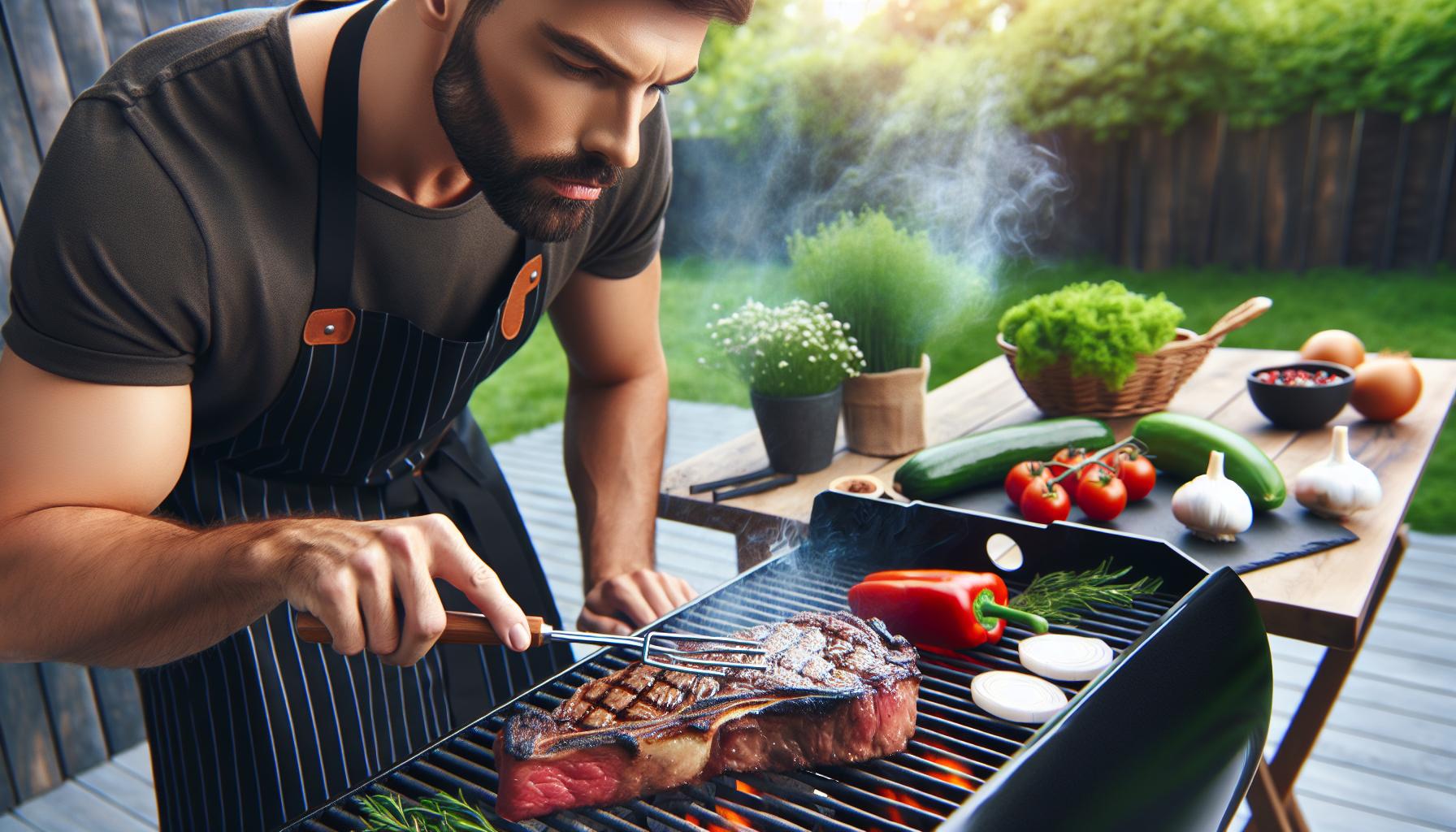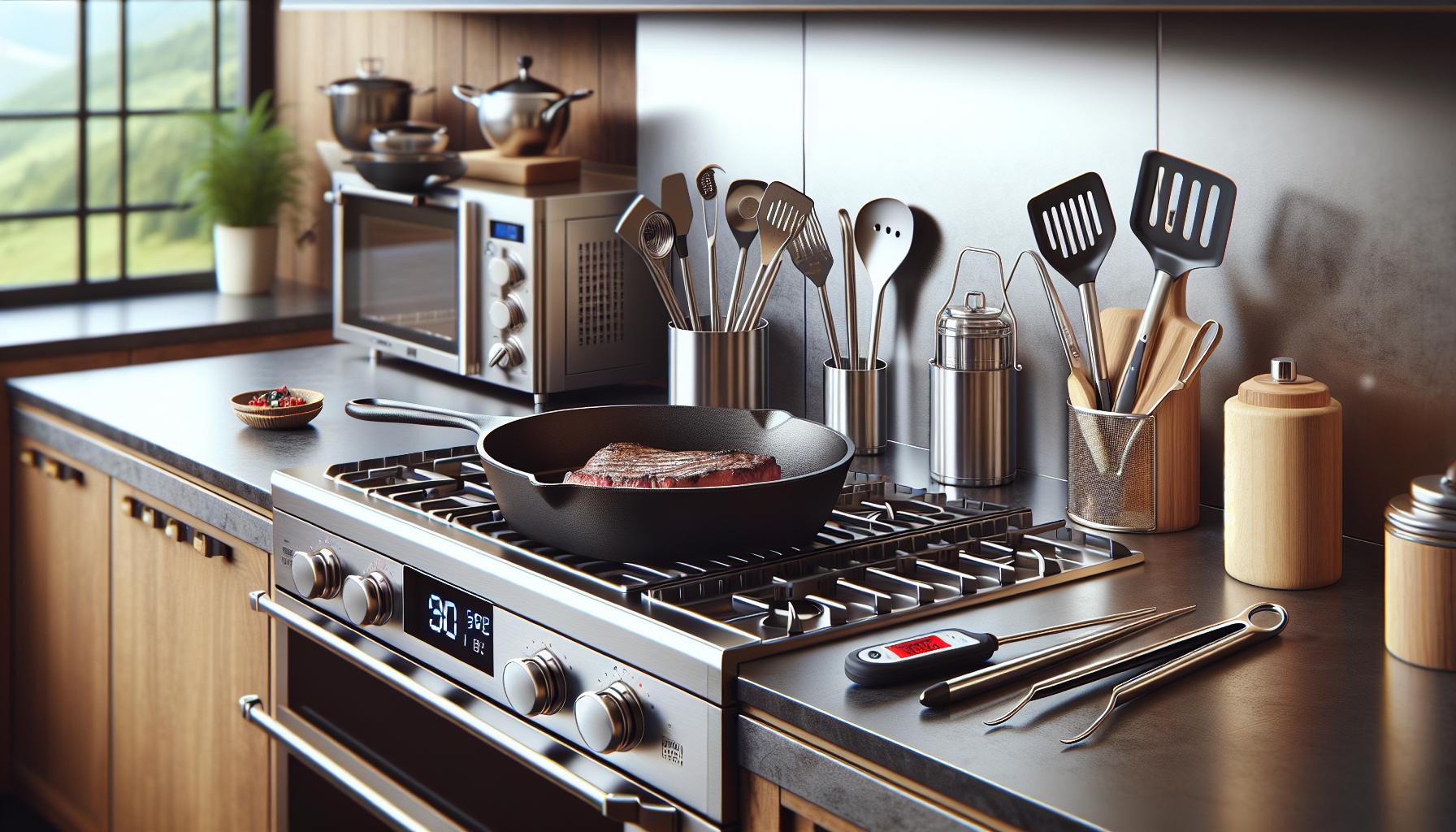Phone:
(701)814-6992
Physical address:
6296 Donnelly Plaza
Ratkeville, Bahamas.

Mastering the art of cooking steak transforms ordinary meals into unforgettable dining experiences. From achieving that perfect medium-rare center to creating a mouthwatering crust, proper steak preparation requires more than just tossing meat on heat and hoping for the best.
Whether you’re a novice cook or a seasoned chef, understanding essential steak cooking techniques can elevate your culinary game. The journey from raw meat to a perfectly cooked steak involves crucial elements like temperature control, timing and the right combination of heat methods. It’s not rocket science, but it’s definitely a science – one that’ll make your taste buds dance and your dinner guests beg for seconds.
Steak cuts vary in tenderness, marbling, and flavor profiles. Each cut offers unique characteristics that influence cooking methods and final taste outcomes.
USDA beef grades indicate meat quality based on marbling content and maturity factors. Prime grade represents superior quality with abundant marbling, comprising only 2% of graded beef. Choice grade features moderate marbling, offering good flavor balance at a more accessible price point. Select grade contains minimal marbling, resulting in leaner meat with less tenderness.
| Grade | Marbling Level | % of Market | Price Range |
|---|---|---|---|
| Prime | Abundant | 2% | $$$$$ |
| Choice | Moderate | 50% | $$$ |
| Select | Slight | 40% | $$ |
Ribeye cuts feature intense marbling throughout the meat, creating rich flavor profiles. New York Strip delivers balanced fat content with a firm texture. Tenderloin offers supreme tenderness with minimal fat content. T-bone combines strip steak with tenderloin portions. Sirloin provides lean meat content at value pricing.
| Cut Name | Tenderness | Fat Content | Best Cooking Method |
|---|---|---|---|
| Ribeye | High | High | Grill/Pan-Sear |
| NY Strip | Medium | Medium | Grill/Broil |
| Tenderloin | Very High | Low | Pan-Sear/Broil |
| T-bone | High | Medium | Grill |
| Sirloin | Medium | Low | Grill/Pan-Sear |

Achieving steakhouse-quality results demands professional-grade equipment. The right tools enhance temperature control, heat distribution, and overall cooking precision.
A heavy-duty cast iron skillet conducts heat evenly, creating the perfect sear on steaks. The ideal pan measures 12 inches in diameter with a thickness of at least 0.5 inches. Additional essential tools include:
| Device Type | Temperature Range | Accuracy |
|---|---|---|
| Instant-read | 32-572°F | ±0.7°F |
| Smart probe | -4-572°F | ±1.8°F |
| Infrared | -58-1022°F | ±2.0°F |
Proper steak preparation enhances flavor development and ensures even cooking. These essential steps create the foundation for achieving steakhouse-quality results at home.
A generous coating of kosher salt penetrates the meat’s surface, creating a flavorful crust during cooking. The ideal seasoning time ranges from 40 minutes to 24 hours before cooking, allowing the salt to break down muscle proteins and enhance moisture retention. For optimal results, apply 1 teaspoon of kosher salt per pound of meat. Black pepper adds aromatic complexity when applied just before cooking.
| Seasoning Type | Amount per Pound | Timing |
|---|---|---|
| Kosher Salt | 1 teaspoon | 40 min – 24 hrs before |
| Black Pepper | 1/2 teaspoon | Just before cooking |
Steaks achieve consistent doneness when tempered at room temperature for 30-60 minutes before cooking. This process reduces cooking time and promotes even heat distribution throughout the meat. Internal temperature rises from refrigerator temperature (35°F) to approximately 65°F during tempering. A room-temperature steak requires 25% less cooking time compared to a cold steak.
| Temperature Stage | Reading (°F) | Time |
|---|---|---|
| Refrigerated | 35-40°F | Starting point |
| Room Temperature | 65-70°F | After 30-60 min |
Mastering specific steak cooking techniques enhances flavor development through proper heat application. Each method offers unique advantages for achieving the perfect balance of exterior crust and interior doneness.
Pan-searing creates a flavorful brown crust while maintaining a juicy interior. A cast-iron skillet heated to 450°F provides optimal heat distribution for even cooking. Professional chefs preheat the pan for 5-7 minutes before adding 1 tablespoon of high-smoke-point oil. The steak sears for 3-4 minutes on each side for medium-rare doneness at 135°F internal temperature. Adding butter, garlic cloves or fresh herbs during the final 2 minutes of cooking elevates flavor through basting. This method excels with 1-inch thick cuts like ribeye or New York strip steaks.
Grilling imparts distinctive smoky flavors through direct high heat exposure. Setting up dual temperature zones creates flexibility – one side at 450-500°F for searing and another at 350°F for controlled cooking. Premium cuts achieve proper sear marks through 45-degree rotation after 2-3 minutes per side. Monitoring internal temperature ensures precise doneness: 125°F for rare, 135°F for medium-rare, 145°F for medium. The meat rests for 5-10 minutes post-grilling, allowing juices to redistribute throughout the steak.
Reverse searing maximizes temperature control through low-and-slow cooking followed by high-heat finishing. Thick steaks cook at 225°F in an oven until reaching 115°F internal temperature. A quick 45-60 second sear per side in a 500°F cast iron skillet creates the final crust. This technique produces edge-to-edge consistency in doneness levels. Digital probe thermometers monitor temperature progression throughout cooking. Steaks 1.5 inches or thicker benefit most from this precise method.
Achieving the perfect steak doneness relies on precise temperature measurements combined with visual indicators. These techniques ensure consistent results across different cuts and cooking methods.
Internal temperature measurements provide the most accurate indication of steak doneness. A calibrated meat thermometer inserted into the thickest part of the steak reveals the following doneness levels:
| Doneness Level | Internal Temperature | Description |
|---|---|---|
| Rare | 125°F (52°C) | Red center, cool interior |
| Medium Rare | 135°F (57°C) | Red warm center |
| Medium | 145°F (63°C) | Pink center |
| Medium Well | 150°F (66°C) | Slightly pink center |
| Well Done | 160°F (71°C) | No pink |
The temperature rises 5°F during resting, so remove steaks 5°F below target temperature.
Professional chefs use specific visual cues to assess steak doneness. The color transition from red to brown indicates cooking progression through the meat. A rare steak displays a deep red center with minimal browning, while medium shows pink with brown edges. The touch test correlates finger positions to steak firmness:
Surface color changes from red to brown indicate cooking progression, complemented by juice clarity transitioning from red to clear.
Proper resting and serving techniques transform a well-cooked steak into an exceptional dining experience. These final steps preserve juices, enhance texture, and ensure optimal flavor distribution throughout the meat.
Resting allows muscle fibers to relax and redistribute internal juices evenly throughout the steak. Place the cooked steak on a warm plate or cutting board, tenting it loosely with aluminum foil to maintain temperature while preventing moisture condensation. The resting duration varies by thickness:
Temperature typically drops 5-10°F during resting, making it essential to account for this decrease when removing steaks from heat. Resting preserves 15% more juice content compared to immediate cutting.
Proper slicing maximizes tenderness by cutting across the muscle grain rather than parallel to it. Position the steak on a stable cutting surface with a sharp carving knife positioned at a 45-degree angle. Identify the direction of muscle fibers running through the meat:
Create uniform slices 1/4 to 1/2 inch thick to ensure consistent texture and presentation.
Mastering steak cooking techniques requires attention to detail precision timing and the right equipment. From selecting premium cuts to perfecting cooking methods every step plays a vital role in creating a restaurant-quality steak at home.
Armed with knowledge about temperature control proper seasoning and essential tools home cooks can confidently prepare steaks that rival those from high-end steakhouses. The key lies in understanding each cut’s unique characteristics and applying the most suitable cooking method.
Remember that practice makes perfect. With these techniques tips and guidelines anyone can elevate their steak cooking game and create memorable dining experiences right in their own kitchen.